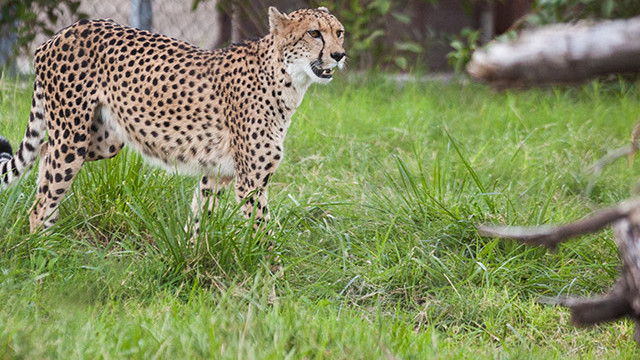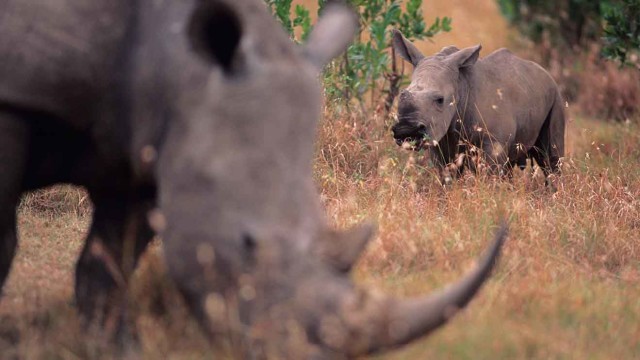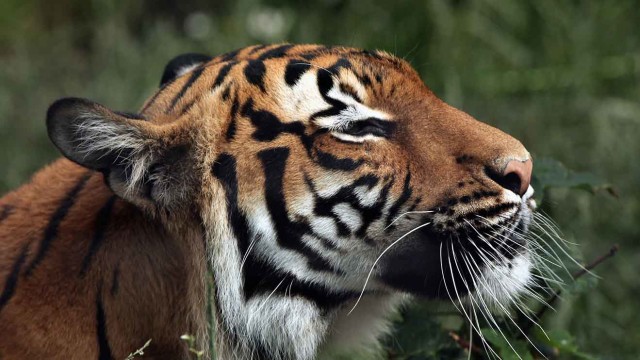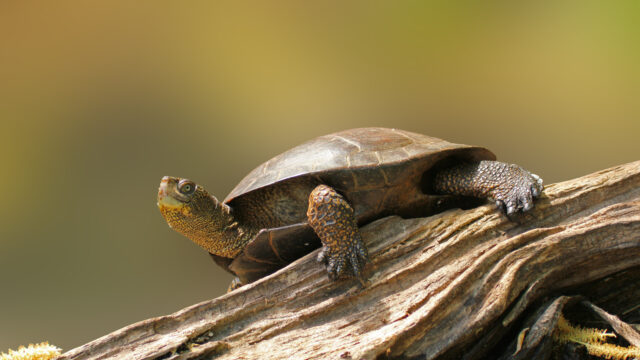Please note, when the forecast is 110 degrees or higher, we will be closing our Butterflies, Roo Walkabout, Safari Café, and Bird Show experiences for the safety of our animals, staff, and guests. The rest of the Zoo will be open for guests to enjoy.
Fresno Chaffee Zoo supports critical research projects that protect and preserve wildlife and wild places around the world. Since 2006, the Fresno Chaffee Zoo Wildlife Conservation Fund has worked with dozens of individuals and organizations to further research, expand conservation impact, share knowledge, and engage local communities.
Fresno Chaffee Zoo Conservation Partners

Action for Cheetahs in Kenya
Action for Cheetahs in Kenya (ACK) was founded in 2001 and works to protect cheetah populations in the Salama and Samburu regions. As human-cheetah conflict becomes a major threat, Actions for Cheetahs in Kenya hopes to find solutions that benefit both the local communities and cheetah populations. The organization is utilizing methods such as radio tracking, cheetah monitoring, and scat analysis to better develop ways to reduce the conflict. ACK has trained scat dogs to locate cheetah fecal samples in order to better understand cheetah’s prey preference, conduct disease and hormone analysis and identify breeding populations. This data will allow the organization to determine what efforts are needed to prevent population isolation and increase the species’ numbers.

Bay Area Puma Project
The Bay Area Puma Project began in 2007 to learn more about the puma population in the San Francisco Bay Area. As human development projects continue to grow, run-ins between people and pumas are becoming more frequent. This project is using motion-sensor cameras, community monitoring programs, and scat dogs to learn more about the population size and movement of pumas in the area. This information will be useful for designating protected areas for the puma and creating policies for land development that reduce the impact on pumas and other native species. They are also working with schools and the community to help residents understand the pumas’ role in the ecosystem and the value of coexisting with the species.

California Condor
Once observed throughout the U.S. and Canada, the California Condor is North America’s largest flying bird with a wingspan of nearly 10 feet! In the 1980’s, the California condor’s population was reduced to only 22 individuals. Desperate to prevent their extinction, the U.S. Fish and Wildlife service brought the remaining 22 condors to various zoos to facilitate a breeding and release program. Zoos have now grown the condor population to over 400, with more than half of those birds flying free in their native habitat today. Fresno Chaffee Zoo supports a nest guarding program that provides 24/7 protection and observation to monitor wild condor nests, provide emergency aid to chicks when necessary, and continue research. The California Condor represents an amazing conservation success story achieved through the hard work and collaboration of government agencies, nature enthusiasts, hunters, and zoos.

Friends of the Island Fox
The island fox is a small fox species found only on the Channel Islands off the coast of Santa Barbara, California. Their near extinction in the 1990s showed the importance of this species to the island ecosystem as plant, animal, and marine species were all impacted. Today, Friends of the Island Fox protects the species through education, conservation, and research. Their education programs for students and tourists promote respectful wildlife viewing on the islands while initiatives like their “fox-proof” trash bins help to reduce sources of human-fox conflict. Their research work also includes health diagnostics to understand the cause and impact of different parasites, as well as monitoring for new diseases.

Giant Armadillo Conservation Project
The Giant Armadillo Conservation Project (GACP), also known as the Pantanal Giant Armadillo Project, was founded in 2011 and operates in the Atlantic forests of Brazil. The giant armadillo is considered ‘vulnerable to extinction’, but despite this, little is known about the species. Due to poaching, it’s likely that state parks in the Atlantic forest are the last hope for the armadillos. Local park officials have joined forces with the GACP research team to uncover information needed to prevent the giant armadillo’s extinction. This project has undertaken large scale population and genetics studies, and is working to create protected areas for the giant armadillos. However, the armadillos currently disrupt the local beekeeping industry and as long as there is conflict, armadillo conservation will face an uphill battle. In response, GACP is conducting a community-oriented project to reduce conflict and encourage participation in conservation.

Grevy’s Zebra Trust
The Grevy’s Zebra Trust was founded in 2007 and is the only organization dedicated exclusively to conserving the endangered Grevy’s zebra. Historically found throughout the east African countries of Ethiopia, Kenya, and Somalia, the species is now found almost exclusively in Kenya. It is now one of the most endangered large mammals in Africa primarily due to a loss of rangeland and limited access to resources. Fresno Chaffee Zoo sponsors the Grevy’s Zebra Warriors in the Laisamis settlement in Kenya.
This group of locals monitors the zebras, guarding the vulnerable population against possible threats and leading community outreach. The Warriors’ presence helps to raise awareness within the communities while reducing instances of poaching and disease, and ensuring access to food and water resources for the zebra.

International Rhino Foundation
The International Rhino Foundation supports conservation and research programs focused on ensuring the long-term survival of the five remaining rhino species throughout Africa and Asia. Fresno Chaffee Zoo helps to sponsor the Sumatran Rhino Rescue program which is taking bold steps to prevent the extinction of this critically endangered species. With fewer than 80 individuals, their numbers have continued to decline rapidly due to poaching and limited breeding. Currently, their small population is spread far apart making it challenging, if not impossible, for individuals to come together to breed. The goal of the current rescue program is to bring the remaining population together in managed breeding centers to increase their numbers before returning individuals back to their protected zones within the National Parks.

Lowland Tapir Conservation Initiative
Tapirs play a critical role in shaping and maintaining the South American ecosystems they live in, which makes them a keystone species. Tapir populations are decreasing due to habitat loss, but the disappearance of such an important species would have a major effect on many other species. The Lowland Tapir Conservation Initiative (LTCI) was established in 1996 and is conducting research in the Atlantic, Pantanal, Cerrado, and Amazon forests to preserve the tapir populations. The LTCI team is hoping to achieve this through population management, research on the tapir populations, and scientific and educational outreach to the local and tourist populations. For example, the LTCI Atlantic forest program has proudly worked with local communities on agroforestry projects designed to restore tapir habitats, while also creating money-making alternatives for families.

Malayan Tiger
Malayan Tigers are one of five remaining subspecies of tigers, with two subspecies already declared extinct. The subspecies, found only in the southeast Asian country of Malaysia, is threatened by habitat loss, poaching, and human-tiger conflict causing their population to drop to only 200 individuals. The Wildlife Conservation Society-Malaysia Program (WCSMP) is working hand-in-hand with zoos throughout the U.S. to find ways to protect these tigers from the path of extinction. Their research and protection efforts include stopping poachers, dismantling snares, preventing illegal trade by increasing checkpoints, collecting data from motion-sensing cameras and finding ways to reduce human-tiger conflict. With all of the collective research and conservation efforts from various projects, the total number of tigers in the wild has increased from about 3,200 individuals in 2010, to almost 3,900 in 2016.

New Nature Foundation
How do you meet the demands of a developing human population while simultaneously protecting a forest that is home to hundreds of iconic and ecologically important species? Surrounding Uganda’s Kibale National Park are ever-growing communities who depend on trees and other natural resources for everyday tasks. New Nature Foundation’s eco friendly fuel initiative reduces dependence on charcoal and wood fuel by creating alternatives such as efficient stoves and biomass briquettes. These initiatives have
saved millions of pounds of wood and thousands of pounds of charcoal, helping to preserve local forests for wildlife while also creating healthier home environments for the community. Their environmental education initiative also helps create a positive relationship between local communities and forest wildlife by fostering a sense of pride in conserving natural resources and providing free access to science, literacy, art, and math education.

Reticulated Giraffe Project
Giraffes, the tallest land animal on Earth, are facing a silent extinction as populations are on a steady decline. Reticulated giraffes are a species of giraffe primarily found in North-East Kenya and the Reticulated Giraffe Project (RGP), based in the Samburu National Reserve, works to protect these populations. Reticulated giraffe populations have decreased by 80% over the last 30 years, leaving an estimated 8,700 individuals. Giraffes face threats such as poaching, growing human populations, and environmental degradation. The team at RGP are studying giraffe behavior and ecology, inspiring local communities through educational initiatives, providing support to protected-area personnel and communities and sharing their research findings to allow for better protections.

Ruaha Carnivore Project
Picture a national park that is more than twice the size of Yellowstone National Park, is internationally recognized for its incredible biodiversity and is a stronghold for Africa’s most iconic carnivores! The Ruaha National Park in East Africa is home to lions, cheetahs, African wild dogs, leopards and spotted hyenas, but is understudied, making extensive research and conservation work a challenge. Ruaha Carnivore project is working to fill this gap in our understanding by conducting a large-scale carnivore tracking project in collaboration with local park authorities and communities. The data obtained from the community-led observations will direct future conservation efforts throughout the Ruaha landscape.

Tanzania Conservation Research Program
Located in the ecologically important Tarangire National Park in Tanzania, the Tarangire Elephant project began back in 1993, and has since developed one of the largest elephant databases. Already, the Tarangire Elephant project has protected over 750,000 acres of Tarangire ecosystem. Expanding on this, the Fresno Chaffee Zoo is currently supporting a project that aims to protect migration corridors surrounding the park for elephant and other wildlife herds. The Tarangire wildlife migration was once the third largest mammal migration in the world! By collaborating with local partners and communities, the Tarangire Elephant Project works to acquire land in critical migration areas and ensures access to nutrient-rich grazing sites for wildlife and livestock.

Western Pond Turtle
Did you know the only freshwater turtle native to our West Coast is the Western Pond turtle? Led in part by Fresno Chaffee Zoo’s Curator of Reptiles, this project provides critical data on the state and sustainability of Western Pond turtle populations right here in the San Joaquin Valley. This group has tracked a local population of turtles since 2007 to assess threats and monitor their response to drought. Currently, they are expanding their study to include health evaluations of individual turtles and research into how the turtles utilize land habitat. The contributions from this project are helping to create effective management and conservation strategies for this unique species.

Wildlife SOS (Sloth Bears)
Sloth bears are an iconic Indian species, but they also have a reputation for being the most dangerous wild animals in India. With the human-sloth bear conflict rising especially quickly in the state of Chhattisgarh, the local government turned to Wildlife SOS to investigate and help solve the issue. In addition to teaching communities ways to stay safe, Wildlife SOS is also conducting a study using GPS collar tracking of sloth bears in the area to understand behavior patterns, general ecology, and sources of conflict. With a greater understanding of the species and community outreach, Wildlife SOS aims to keep both the sloth bears and local communities safe while promoting coexistence.

Fresno Chaffee Zoo is a Seafood Watch® partner. Through the Monterey Bay Aquarium Seafood Watch Program, consumers receive recommendations on ocean-friendly seafood showing which seafood items are “Best Choices” or “Good Alternatives,” and which ones you should “Avoid”.
The Seafood Watch program uses a variety of data to develop consumer guides, which are updated two times per year. Information about fish populations, the type of gear used and the impact on the environment as well as other species are all considered. Both wild caught and farmed species are assessed.
Consumer guides are available at the Fresno Chaffee Zoo in the Sea Lion Cove and Stingray Bay areas. A free mobile app is also available. To find out more information about the Seafood Watch program, or to download the mobile app, please visit www.seafoodwatch.org.

Sumatran Orangutan Conservation Program
The goal of the Sumatran Orangutan Conservation Programme (SOCP) Jantho Reintroduction Program in Aceh on the Island of Sumatra, Indonesia, is to rescue, rehabilitate and release ex-captive Sumatran orangutans (Pongo abelii; Critically Endangered) and establish a new, self-sustaining population in the Jantho Nature Reserve, serving as a safety net population should catastrophe befall the remaining naturally wild orangutans. In addition, they empower local people to directly work with us on these efforts, building capacity for long-term, local conservation action while inspiring the wider community and youth to act as advocates and protectors of orangutans and the forest.

Sumatran Songbird Conservation Program
In order to combat the songbird crisis in Southeast Asia, the SSCP is constructing a new captive breeding facility in North Sumatra, Indonesia, to facilitate focused breeding programs for highly endangered Sumatran songbird species, in accordance with recommendations from the IUCN SSC Asian Songbird Trade Specialist Group. Some of these species include the critically endangered Sumatran laughingthrush and Nias Hill myna. Additional goals are to support the program through community education programs and develop strategies for release and post-release management.


















